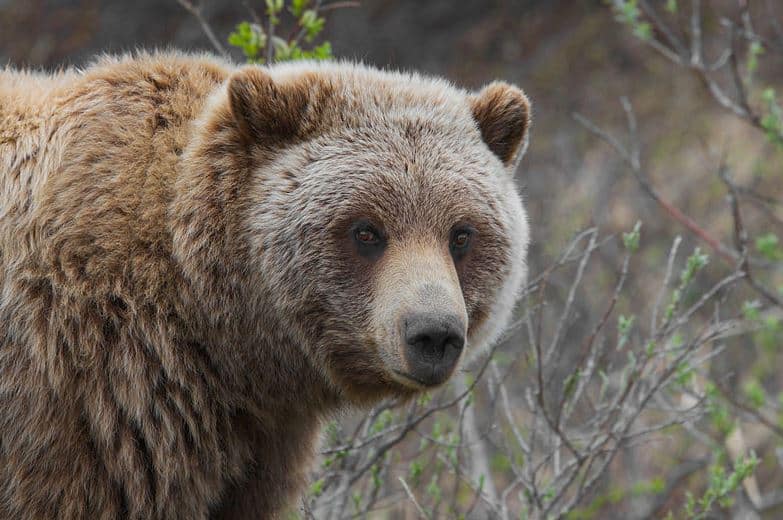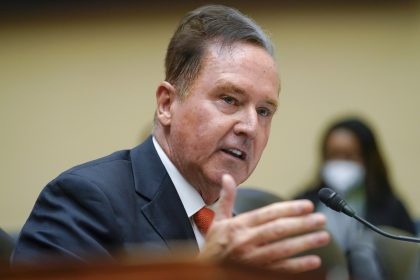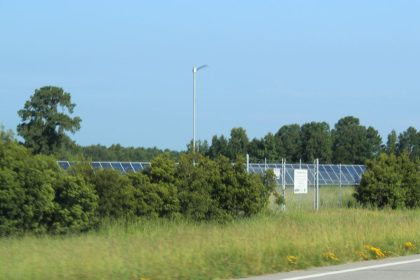Wyoming Petitions for Control of Grizzly Bear Population in Greater Yellowstone Ecosystem

The grizzly bear population in the Greater Yellowstone Area could potentially, for a third time, be delisted from the federal Endangered Species List — following a petition from Republican Gov. Mark Gordon. The petition, which cites the species as “fully-recovered” and something to celebrate, is one more piece in a decades-long series of legal battles between state wildlife agencies and conservationists.
“This is a notable day of celebration not only for the grizzly bear, but for Wyoming. The Greater Yellowstone Ecosystem grizzly bear has met and exceeded all scientific benchmarks for recovery,” Gordon said in a press conference. “We have proved time and time again that we are experts in wildlife conservation for our state’s valued and iconic species.”
The state of Wyoming joins Idaho and Montana as part of a trifecta of states with land in the GYE, and has been in control of managing bear populations during the species’ time on and off the endangered species list. It is an effort the state claims has cost 46 years and $52 million. It is also one that many have hailed as a shining example of animal conservation efforts.
“When we say fully recovered, that means that we have a population that is not only meeting the population standards, as defined by the U.S. Fish and Wildlife Services, but that it is also meeting the sustainability requirements,” Rebekah Fitzgerald, communications director, Wyoming Game and Fish Department, said “That really points to the fact that we are going to … maintain a suitable and sustainable population that is genetically diversified as laid out in our management plan.”
Protection of the grizzly bear began in 1975 when, under the authority of the Endangered Species Act, the FWS listed four distinct populations of grizzly bears in the lower 48 states as threatened. The listing began a decades-long project by state and federal conservationists to bring back a species which had been reduced to a habitat range as little as 2% of its former scope.
In 1993, a recovery plan was formulated and enacted by states which detailed how to repopulate the grizzly population and take back strategic control from the U.S. Fish and Wildlife Service. The plan devised a management strategy for bear-human interactions, banned hunting and laid out general recovery efforts with a six-year timeline. In 2003, those goals were met, and in 2005, the first petition to delist the grizzly bear from the Endangered Species List began.
In 2007, that petition was successful, in part because the mathematical equations related to counting bear populations had been revised to a higher count, and states began management of the grizzlies using a revised recovery plan based on the one from 1993. This delisting caused a stir within citizen conservationists, who claimed the state changed the formula to sell trophy-hunting licenses, and a legal battle started which ended with a federal judge relisting of the grizzly bear in 2009 — citing the states had failed to consider the effects of the loss of food resources, specifically the whitebark pine nut, on the bear population.
The situation stayed fairly static for eight years until a petition from the Yellowstone Ecosystem Subcommittee, the Interagency Grizzly Bear Committee, and Interagency Grizzly Bear Study Team claimed that the grizzly bears in the GYE actually had adequate alternative food sources outside of the whitebark pine nut, and that the conservation efforts, which had repopulated the grizzly population to close to 700, were a success. The petition successfully caused the second delisting of the grizzly bear from the Endangered Species List, and states again enacted their own management systems of the species.
This ruling was quickly thrown away, however, when in 2018 a U.S. District Judge again placed the grizzly on the Endangered Species List. This most recent petition by Gordon follows this relisting, and has been accompanied, again, by a change to the estimation process used in the counting formulas of bear populations.
“As science continues to evolve in trying to understand the best way to count grizzly bears, those models have shifted and changed,” Fitzgerald said. “It’s still conservative, but it’s not as conservative”
The changes have shifted the grizzly bear population in the GYE from about 700 bears to around 1000. This formula change, however, has met with criticism in much the same way it did in 2007.
“When counting in the Greater Yellowstone Ecosystem, there’s a sleight of hand,“ Doug Peacock, a longtime grizzly bear conservationist and founder of Save The Yellowstone Grizzly organization, said. “Counting Grizzly Bears is almost a cottage industry. It’s a guess. It’s an extrapolation… Only last year they were claiming there were 700 grizzlies in Yellowstone, and all of a sudden now they have arbitrarily jacked that up to 1000.”
It’s an effort, Peacock claims, to again make grizzly bears in the GYE huntable. More specifically, for the state wildlife departments to sell trophy-hunting licenses.
“It’s the end game of Wyoming’s petition. They want to be able to hunt the bear, and sell trophy-hunting licenses.” Peacock continued. “They want to control the bears. They want to feel like they can own the bears like some kind of game animal that is just worth hunting license fees… It’s not the only measure of a bear.”
While the Wyoming Game and Fish Department did not confirm whether hunting of grizzlies in the GYE would be available if the state were awarded management, history has shown Wyoming edges towards hunting as a reliable population maintenance tool, and has sought to sell hunting licenses of grizzlies during time periods when the species was not listed on the Endangered Species List.
“I don’t believe that Yellowstone’s grizzlies will ever be hunted without driving that population into extinction. Right now, the Yellowstone grizzly population is genetically and physically isolated. It doesn’t wander successfully,” Peacock said.
If awarded control, the state of Wyoming plans to keep the GYE grizzly population stable at around 1000. To ensure genetic health, Wyoming has outlined a plan which includes monitoring and transplantation of grizzly bears from other states should the population get low. While utilizing hunters to maintain these populations has been met with repeated controversy, the state maintains that its citizens deserve the right to the animals on its land.
“Under Wyoming state law, the wildlife belongs to the people. And, at the end of the day, we believe state management is the best way to manage these bears. And for us, knowing that they are biologically recovered is the greatest success story — it’s one of the greatest success stories of the Endangered Species Act to date.”
Once Wyoming finishes the draft of the official petition in the next few weeks, they will present it to the U.S. Fish and Wildlife Service who will, within 90 days, decide whether or not to do an in-depth study. Following their decision, the FWS has 12 months to decide whether or not to delist species. Throughout this process, there will be many opportunities for public engagement through the FWS open forums.

























